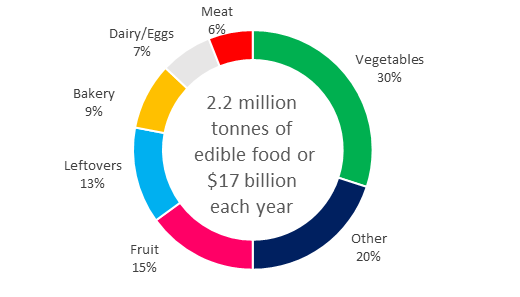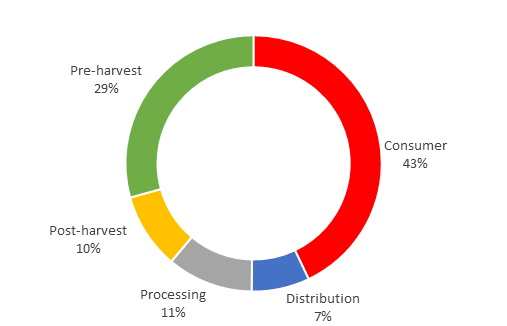
Once upon a time, there was an apple. It was born from a beautiful blossom in May on an apple tree. Since the day it was born, the apple was dreaming of becoming big and sweet, and one day, it hoped to be able to satisfy someone’s hunger. The apple was growing and getting bigger and bigger, until it got red and ripe, and was picked by a farmer in September. The farmer then placed the apple into a box along with all its friends, and that’s where the apple’s journey began. It was loaded into a truck and transported to a shelf in a grocery store. One day in the grocery store, someone fell in love with it, put it in their basket, brought it home, and introduced it to new friends living in a fruit bowl on the countertop. The apple was anxiously waiting for the day when someone would pick it up and eat it. Its mission would then be complete. But something did not go according to the apple’s plan. The apple stayed in the fruit bowl for a day, a week, a month, until it got wrinkled and lost its appeal. The apple was not loved anymore and, one day, it was thrown away into the garbage. Sorry, this story did not have a happy ending, like a lot of other avoidable food waste stories.
Have you ever thought about how much food waste you produce? Have you ever investigated where that wasted food goes and what the consequences are for the environment and economy? How can technological innovation help? Do you think that you can make a difference?
Countries around the world are concerned about the high percentage of food waste and are looking for solutions to reduce it. A recent report by ICTC, Canadian Agri-Food Technology: Sowing the Seeds for Tomorrow, shows that technology plays a fascinating role in the agriculture sector and how prioritized investments in agri-food technological innovation and digitization can become a solution to the waste problem.
What is Food Loss or Waste?
Food loss and waste (FLW) refers to food that was produced but not eaten and then thrown in the garbage. Some sources distinguish food loss from food waste. Food loss refers to “the decrease in the quantity or quality of food resulting from decisions and actions by food suppliers in the chain, excluding retailers, food service providers, and consumers.” Food loss occurs during earlier stages, production, post-harvest, or during processing and happens for reasons like not having the appropriate storage conditions, poor food handlining practices, packaging issues, weather conditions, etc. Food loss implies that food does not re-enter the food chain in any other productive form, such as animal feed. In contrast, food waste refers to “the decrease in the quantity or quality of food resulting from decisions and actions by retailers, food service providers, and consumers.” Food waste happens for several reasons: the food may not have an appealing look, shape, form, or colour; the food is close to, or passed, its “best before date”; and this includes unused and discarded food from households and restaurants.
Food waste and food loss is often avoidable and unnecessary. Avoidable FLW (food loss and waste) refers to edible food that was thrown out. As an example, an apple that reached a grocery store shelf but was not purchased by a consumer, or an apple that was purchased by a consumer but was not eaten and thrown out. It could also be a can of food that reached the best before date but was not consumed and thrown away. Unavoidable FLW refers to inedible food that was thrown out, for example, animal bones, husks, peels, eggshells, etc.
Why is Food Waste a Problem?
FLW has environmental, economic, and social implications. Discarded food means that all the natural and human resources used to grow, produce, process, and transport that food were wasted as well. Research shows that the amount of food thrown away each year exceeds $1,760 per Canadian household. Moreover, the food that ends up being thrown into the garbage requires financial and human resources to manage its disposal. FLW is also responsible for a significant environmental footprint. Wasted food that ends up in a landfill produces methane, a greenhouse gas that is 28-34 times more potent than C02. It is estimated that 7%-10% of global greenhouse gas emissions are associated with FLW. To put this in perspective, Canada’s avoidable household food waste is equivalent to the C02 produced from approximately 2.1 million automobiles currently on the road today.
How Much Food Do We Lose/Waste?
The United Nations Food Waste Index Report estimates that 931 million tonnes of food waste was generated globally in 2019, which is the equivalent to 17% of the total global food production. Research shows that more food is wasted per person in higher-income countries compared to lower-income countries. It is hard to precisely calculate how much food is lost and wasted in Canada: there are many ways to measure food loss and waste, and their results are highly variable.
According to 2017 research conducted by the National Zero Waste Council, 63% of the food Canadians throw away could have been eaten. This means that Canadians throw away almost 2.2 million tonnes of edible food, which cost them over $17 billion. For an average Canadian household, this is equal to 140 kg of wasted food per year, with a cost per household of more than $1,100 per year.
What is Wasted in Canadian Households?

Source: Love Food Hate Waste
Another piece of research from 2017, conducted by the Commission for Environmental Cooperation, estimated that Canada generates around 13 million tonnes of food loss and waste per year, which equals 396 kg per person per year. Canadian research conducted by Second Harvest and VCM International from 2019, shows that 58% of all food that is produced ends up being either lost or wasted.
Who Wastes the Most?
Opinions differ in determining at what stage the highest proportion of FLW occurs. The United Nations Environment Programme estimates that globally, 61% of all FLW came from households, 26% from food services, and 13% from retail. According to the same research, Canada is one of the countries with high household food waste, equivalent to 79 kg per capita. Research conducted by the Commission for Environmental Cooperation in 2017 suggests the highest proportion of food is wasted at the consumer level, at 170 kg per capita per year or around 43% of total generated FLW in Canada.
Estimates of FLW Across the Food Supply Chain in Canada

More recently, a 2019 study by Second Harvest and VCM International found that consumers are only responsible for 14% of total FLW in Canada or 21% of total avoidable FLW in Canada, whereas the production stage is responsible for the highest proportion, equivalent to 24% of total FLW and only 6% of avoidable FLW each year. The main reasons behind FLW during the production stage include imperfect shape or size, excess supply, cancelled orders, market price below cost of production, and the inability to harvest crops at peak quality due to labour shortages.
What Has Been the Impact of COVID-19 on Food Waste?
COVID-19 raised a lot of issues, food waste being one of them. Interestingly, three-in-ten Canadians have recently read or heard something about the amount of household food that is thrown away. The vast majority (94%) of Canadian consumers are motivated to reduce their FLW, and see FLW as an important national issue. Canadians tried to waste less food during the COVID-19 pandemic, however, since the beginning of the COVID-19 pandemic, 61% of Canadians were buying more food items per grocery trip than normal. According to 2020 survey results, one in four (or 24%) Canadians reported throwing away less uneaten food than before the pandemic, 14% reported throwing away more, 50% reported no change, and 12% suggested they don’t throw away any food at all. According to another survey from August 2020, nearly half (or 48%) of respondents across Canada reported that they have wasted less food since the start of the COVID-19 pandemic.
Can Technology Help?
In November 2020, the Government of Canada announced a new initiative called the Food Waste Reduction Challenge. Under this initiative, the government allocated $20 million over five years toward the most innovative food waste reduction proposals. The government is looking for novel technological solutions that focus on preventing or diverting food waste at any point from farm to plate, extending the life of food, or transforming food that would otherwise have been lost or wasted. The challenge, which will end in Summer 2023, is broken into four streams:
1. Business models that prevent food waste
2. Business models that divert food waste
3. Technologies that extend the life of perishable foods
4. Technologies that transform food waste by converting surplus food, food by-products, or food waste into other products
Find more information about the Food Waste Reduction Challenge.
Source: Food Waste Reduction Challenge: Novel Technologies
What Can Consumers Do to Reduce Food Waste?
Everyone has a role to play in addressing FLW, including consumers. There are several ways to reduce food waste as a consumer:
- Become more aware and educate yourself about FLW
- When choosing produce, focus less on “is this perfect for Instagram” and more on freshness
- Use “best before” date as a guide rather than an “expired, not safe to eat” date
- Be mindful and conscious of wasting food — shop sustainably, don’t buy too much, take inventory of food at home, make a list, plan your meals and eat leftovers
- Store perishable foods properly to make them last longer, freeze food to extend its life
- Donate excessive food to people in need
- Participate in organic waste collection programs in your area or use sustainable ways to dispose of inedible food waste, like food waste composters Lomi, Pela, Tero or others
- Buy items that are “reduced to sell quickly” to save money and prevent food waste, or use mobile applications like Flashfood to locate fresh food items that are nearing their best before date at grocery stores
To see what difference you can make, check the Greenhouse Gas Calculator for Waste Management to estimate your contribution to emission reductions.
